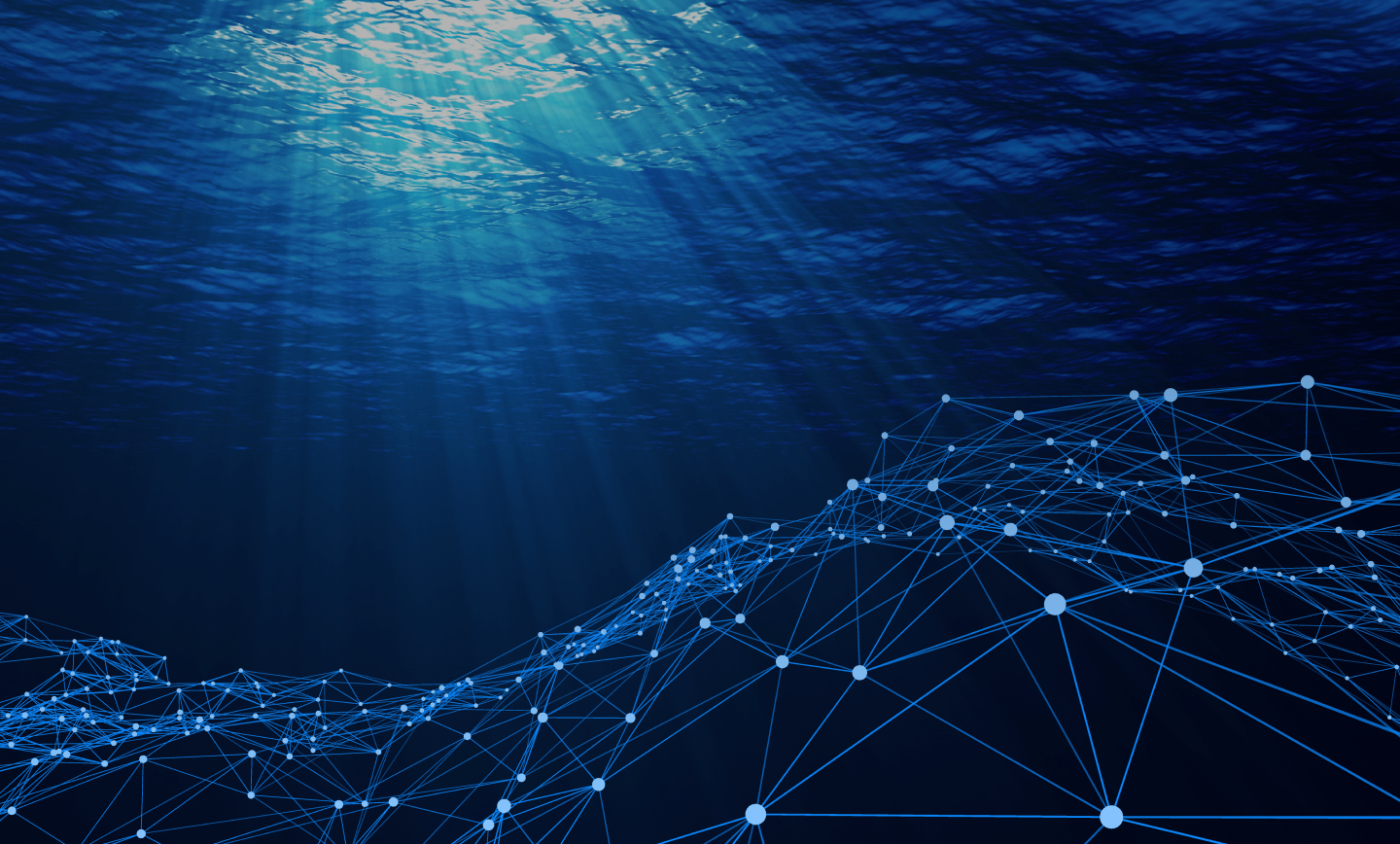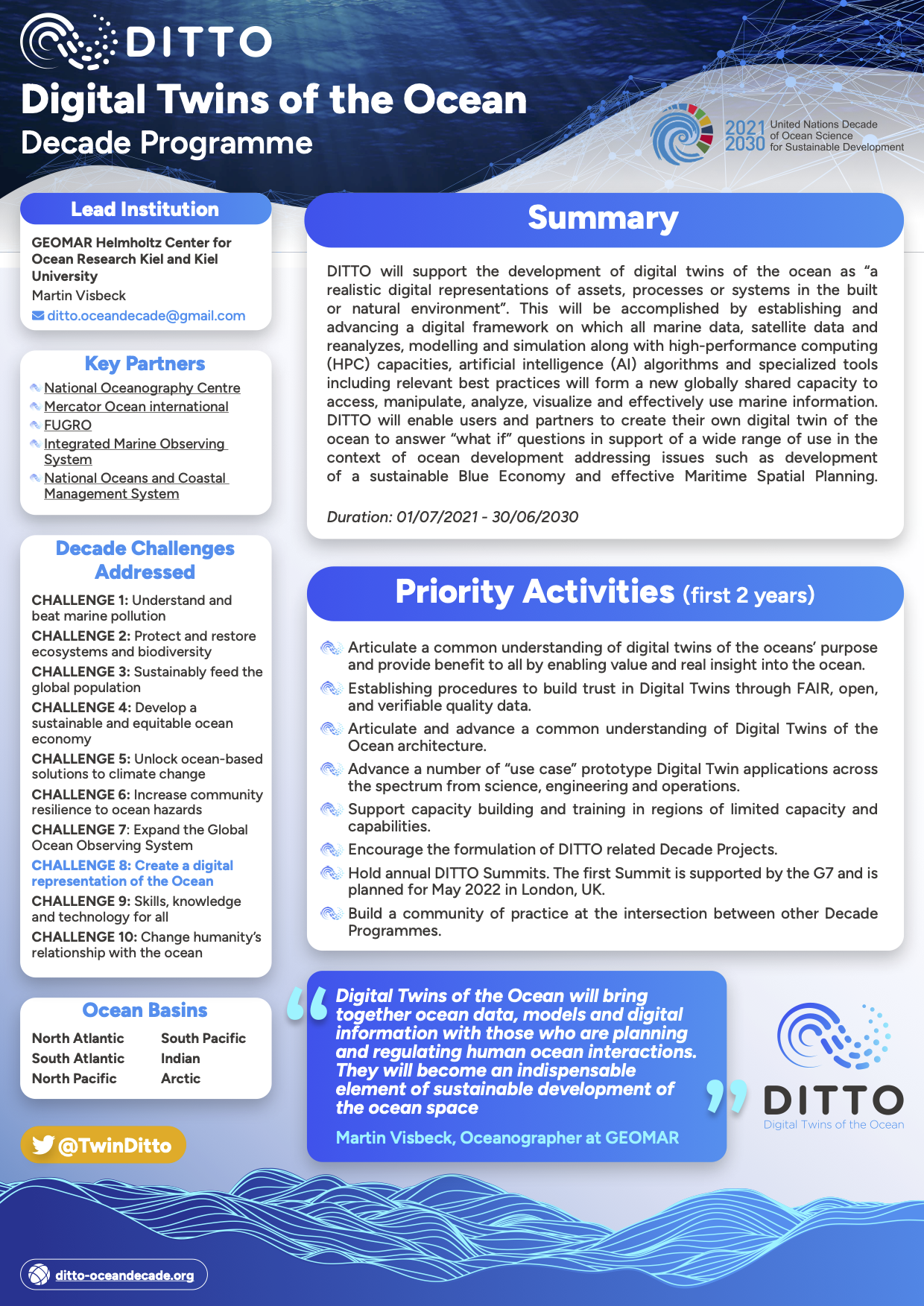DITTO supports the development of digital twins of the ocean as a realistic digital representations of assets, processes or systems in the built or natural environment. This will be accomplished by establishing and advancing a digital framework on which all marine data, satellite data and reanalyzes, modelling and simulation along with high-performance computing (HPC) capacities, artificial intelligence (AI) algorithms and specialized tools including relevant best practices will form a new globally shared capacity to access, manipulate, analyze, visualize and effectively use marine information.
DITTO enable users and partners to create their own digital twin of the ocean to answer "what if" questions in support of a wide range of use in the context of ocean development addressing issues such as development of a sustainable Blue Economy and effective Maritime Spatial Planning.
VISION
The Vision of the DITTO Programme is a world where Digital Twins of the Ocean are used to support ocean protection, ocean governance and a sustainable Blue Economy.
MISSION
The Mission of DITTO is to develop and share a common understanding of digital twins of the ocean (DTO); to establish best practice in the development of DTOs; and advance a digital framework for DTOs to empower ocean professionals from all sectors around the world including scientific users, to effectively create their own digital twins.
AMBITION
Digital Twins will enable users to address ‘What if’ questions based on shared data, models and knowledge. DTOs empower ocean professionals, citizen scientists, policymakers, and the general public alike to visualise and explore ocean knowledge, data, models and forecasts. The use of Digital Twins is wide and rapidly developing spanning a wide range of use cases from engineering to policy to science to operational services. DITTO will promote co-design of twins, education and uptake to demonstrate the value in the Digital Twins.
DITTO White Paper
The DITTO Whitepaper defines the concept of digital twins of the ocean, lays out the challenges, opportunities for actions and suggestions for their implementation. Moreover, it introduces the six working groups of DITTO, each focusing on one key element in the development of digital twins of the ocean:
WG 1: Supportive ocean observations and data delivery
WG 2: Data analytics and prediction engines
WG 3: Data lakes and interoperability
WG 4: Interactive layers and visualisations
WG 5: Framework – architecture, design and implementation
WG 6: Education, training and capacity development
DITTO Steering Committee (2024-2027)
leading Co-Chairs (2024-mid 2026)
- Joanna Staneva (Helmholtz Zentrum HEREON, Germany)
- Fei Chai (Xiamen University, China)
- Marina Tonani (Mercator Ocean International, France)
- Swadhin Behera (JAMSTEC, Japan)
- Anna Hermsen (Netherlands)
- Alain Arnaud (Mercator Ocean International, France)
- Avichal Mehra (NOAA/NWS/NCEP/EMC, USA)
- Deanesh Ramsewak (Centre for Maritime and Ocean Studies (CMOS) at UTT, Trinidad and Tobago)
- Di Wan (Fisheries and Oceans Canada / Pêches et Océans Canada, Victoria, Canada)
- Giovanni Coppini (Euro-Mediterranean Centre on Climate Change (CMCC) Foundation, Italy)
- Irikomuni Zauisomue (University of Namibia, Namibia)
- Joaquin Tintore (SOCIB and IMEDEA (CSIC-UIB), Spain)
- Mathew Palmer (Plymouth Marine Laboratory, UK)
- Patrick Heimbach (University of Texas at Austin, USA)
- Sung Yong Kim Korea
- Urmas Lips (Tallinn University of Technology, Estonia)
- The SC has direct communication with the network of DITTO implementing partners, the Ocean Decade Coordination Unit, the Ocean Prediction DCC, other relevant Ocean Decade Programs, DITTO affiliated projects, and regional, national and community based digital ocean twinning activities.
The DITTO steering committee is a group of individuals from different scientific backgrounds and countries, who are deeply engaged in issues related to digital twins. The now selected steering group is expected to elect a chair and vice chairs from within the SC to lead the work of the committee.
The ECOPs community will select 2-3 further members of the ECOPs community to the complete DITTO SC.
You can reach out to the DITTO Steering Committee via the following email: ditto.oceandecade@gmail.com .
"Digital Twins of the Ocean will bring together ocean data, models and digital information with those who are planning and regulating human ocean interactions. They will become an indispensable element of sustainable development of the ocean space"
Martin Visbeck
Oceanographer at GEOMAR

